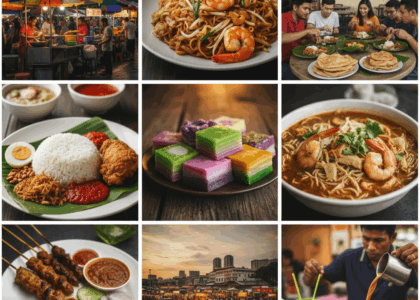Malaysia is a land of stunning contrast, from its bustling modern cities and colonial heritage to its ancient rainforests and world-class tropical islands. However, planning a trip here comes with one crucial consideration: the weather. Located close to the equator, Malaysia has a hot and humid tropical climate year-round, but its two monsoon seasons mean that the best time to visit depends entirely on where you want to go!
The secret to year-round travel in Malaysia is knowing which coast is “in season.” Here is your ultimate guide to finding the perfect time for your Malaysian adventure.
The Malaysian Weather Compass: East vs. West
Malaysia’s geography—Peninsular Malaysia is split by a central mountain range, and then there is the island of Borneo—creates two distinct weather systems. This is the golden rule for planning your trip:
| Region | Best Time to Visit (Dry Season) | When to Avoid (Wet Season) |
| Peninsular West Coast (Langkawi, Penang, Kuala Lumpur) | November to March | April to October (afternoon showers) |
| Peninsular East Coast (Perhentian Islands, Redang, Tioman) | March to October | November to February (heavy monsoon and closures) |
| Malaysian Borneo (Sabah & Sarawak) | March to October | November to February (wetter, particularly Sarawak) |
Export to Sheets
1. The Peninsular West Coast: Your Winter Escape
If your dream vacation involves exploring the cultural hotspots and famous beaches of the West Coast, plan your visit for the northern hemisphere winter.
- Best Months: December, January, February
- What to Expect: Sunny days, minimal rainfall, and calm seas. Temperatures are comfortably warm, averaging around 27∘C–30∘C.
- Perfect for: Beach days in Langkawi and Penang, snorkeling/diving (especially March is great for this), and city exploration in Kuala Lumpur and Malacca.
- Keep in Mind: This is peak season, especially around Christmas and Chinese New Year (Jan/Feb), so book your accommodation well in advance.
- Shoulder Season (March & November): March is a wonderful transition month with generally great weather before the West Coast begins its wetter period. November sees the start of the dry season, offering a good balance of weather and fewer crowds.
2. The Peninsular East Coast: Your Summer Beach Destination
The East Coast islands, famous for their spectacular clear waters, diving, and powdery white-sand beaches, are best enjoyed during the middle of the year.
- Best Months: May to September
- What to Expect: The height of the dry season with perfect weather for beach lovers. Calm, turquoise seas make for excellent swimming, snorkeling, and diving conditions, particularly around the Perhentian Islands, Redang, and Tioman Island.
- Perfect for: Diving trips, island hopping, and sunbathing.
- Keep in Mind: July and August are the busiest months due to European school holidays. This is the time to visit if you prioritize perfect beach weather.
- Wet Season (November to February): During the Northeast Monsoon, the East Coast experiences heavy rains and rough seas. Many island resorts will close down completely, and ferry services may be severely disrupted or suspended. It is best to avoid this region during these months.
3. Malaysian Borneo: Wildlife and Rainforests
The states of Sabah and Sarawak, located on the island of Borneo, offer jungle adventures, orangutan spotting, and world-class diving.
- Best Months: March to October
- What to Expect: The relatively drier season, which is ideal for trekking, wildlife viewing, and scaling Mount Kinabalu. The seas are calmer, making it the perfect time for diving and spotting marine life. Orangutans are also easier to spot during the drier periods.
- Perfect for: Jungle trekking, diving at Sipadan, wildlife encounters in Sepilok and along the Kinabatangan River, and cultural festivals like the Harvest Festival (Pesta Kaamatan) in May.
- A Note on Rain: As an equatorial rainforest, Borneo is humid and will experience rainfall year-round, even in the “dry” season. Showers are typically short, heavy bursts. The wet season (November to February) is more pronounced, especially in Sarawak.
Planning for Cities and Highlands
Not all of Malaysia is about the beach. Here’s what you need to know about key city and inland destinations:
- Kuala Lumpur (KL) & Malacca: The capital is hot and humid all year, with temperatures hovering around 32∘C. It experiences rain throughout the year, usually in the form of short, sharp afternoon downpours. The slightly drier months are generally January, February, July, and August, but a spontaneous shower is always possible.
- Cameron Highlands: This is your cool escape! Located at a higher altitude, temperatures are much cooler, averaging a pleasant 22∘C in the daytime. The climate is great all year, but it sees the most rain from September to December. If you prefer the driest days for hiking the tea plantations, aim for January, February, June, or July.
When is the Absolute Best Time to Visit Malaysia?
The answer hinges on what you want to see, but if you want the best possible chance to combine all the main highlights with good weather, look at the shoulder months.
Overall Sweet Spot: April, May, and October
These transition months are excellent times to visit because they sit just as one coast is getting ready for its dry season and the other is just finishing its wet season, maximizing your options:
- April – May: The East Coast islands are reopening to stunning weather, while the West Coast is still enjoying favorable conditions before the peak of its rainy season.
- October: The East Coast is still beautiful and less crowded as its season winds down, and the West Coast is preparing for its dry, peak season.
Ultimately, Malaysia offers something wonderful in every month. Just choose your region, check the monsoon pattern, and get ready for a truly unforgettable tropical adventure!






